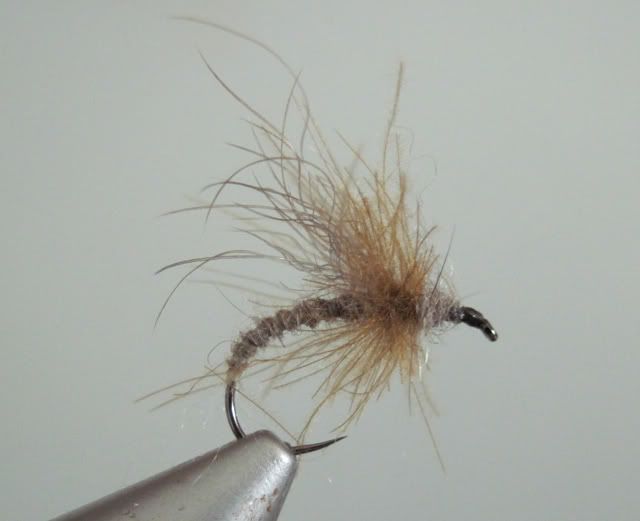A Large Dark Olive Emerger.
Thoroughly enjoying all the playing with emergers, over the past week lead me to think i might do a wee SBS.
This one is based on colours ala Greenwells and my own observations.
So here goes.
Hook : SLD 12 Modified, might be better to use a hook the right shape to start with

Thread: Dark Dun
Tail: White polar fibre
Abdomen: Mix of Muskrat and Opposum hair, to get a rusty greyish olive colour.
Rib: Pearsalls no.4 or 5
Wing: Snowshoe hare dyed Grey with a pantone marker
Hackle: Olive CDC
Thorax: Some more Muskrat/opposum mix with a few guard hairs thrown in.
Step 1: Put hook in vice.

Step 2: Bend hook if necessary

Step 3: Start the thread and then take a few Fibers of polar fiber.

Step 4: Tie in the polar fiber.

Step 5: Tie down to half way round the bend , adding the silk ribbing material as you go.

Step 6: Take a pinch of muskrat and a pinch of Opposum hair and roughly mix together.

Step 7: Dub the fur quite tightly with a small amount of taper.

Step 8: Wind dubbing rope back up the shank about 2/3rds the length of the fly.

Step 9: Make 2-3 turns of the rib at the tip of the fly and then wind up the body.

Step 10: Next select a few Snowshoe hare fibers and remove the under hair.

Step 11: Tie in the snowshoe hare and hit it with the marker to make it grey.

Step 12: Form a small dubbing loop.

Step 13: Take a pair of Olive CDC feathers with a nice length of fiber, about the hook length.

Step 14: Insert one half of the feathers into the dubbing loop.

Step 15: Trim along the stalk and do the same for the other side.

Step 16: Try to get the longer fibers closest to the hook and then spin the twister.

Step 17: Wind the twisted CDC rope onto the hook, about 3-4 turns stroking each turn backwards and upwards as you go.

Step 18: Tie off the Rope and then dub some more of the fur, a little more roughly this time.

Step 19: Wind it forward to form a nice small thorax.

Step 20: Whip finish and varnish the head

Step 21: Finally pick the fur out on the thorax to make it a more scruffy and stroke the CDC so the bulk of it sits above the horizontal. And there you have a finished Large Dark Olive.

If you were to use Blue Dun CDC you can make this into a Blue winged Olive, might need to go a hook size or two smaller as well.

If the snowshoe hare is left Natural, it makes a lighter variant, possibly good as a pond olive, although this picture has Blue Dun CDC, with a light natural or golden olive it would be a good match.

With a Mole Body and Red rib, with dark dun or natural Black CDC it is the Iron Blue Dun

With Camel Fur, Natural Snowshoe (although this has Cream EP), Pale grey CDC and a yellow rib it is a Yellow May.

There are Endless variations to choose from to match the hatch you are fishing and keep you amused at the vice.
Cheers
Sandy

